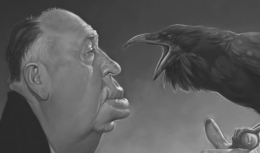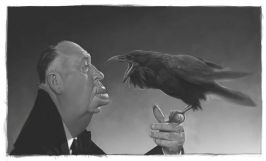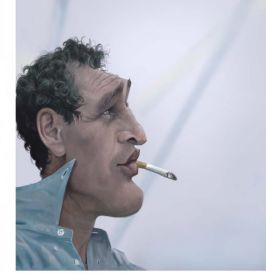Interview with David Boudreau
 | |
| Author | Debbie Burmeister |
|---|---|
| Subject | |
| Genre | |
| Published | EF Issue 2018.4 |
Publication date | Fall 2018 |
| Media type |
|
| Pages | 20- |
| Website |
|
Debbie Burmeister interviews ISCAcon27 (San Diego) Guest of Honor, David Boudreau.
Article Transcript
This is our second of two interviews we have with people who will be giving seminars at this year’s conventions. Both interviews are of artists who are attending the convention for their first time. They also both just happen to be working for Fox Animation. The parallels and similarities between the two are interesting. And so are the contrasts. That is why you will see some similar questions between the two interviews, but the answers are as unique as the artists themselves. Hopefully, these interviews will compel you to find out more about their work and ask them even more questions at the convention.
Q: Hi, David! Our members are eager to learn more about you and your work. First, let’s introduce you to our readers. Where are you from?
A: I was born in Boston, Massachusetts. but grew up in Nova Scotia, Canada. I now live in Hollywood, California.
Q: When did you first know you were interested in art?
A: It sounds cliché, but since I was old enough to hold a pencil.
Q: Are you self-taught? Or did you go to school for this?
A: For the most part I am but then honed my skills in college and I still continue to learn. I went to Sheridan College and studied Classical Animation from 1987- 1991.
Q: I see that you are currently working for Fox Animation.
A: Yes, I am a Story Revisionist on American Dad. I’ve been with FOX ANIMATION off and on since 2009, starting on Family Guy.
Q: So what is a typical workday like for you?
A: That’s a loaded question. I start my day with a coffee. After that, lots and lots of drawing and meeting deadlines. Every day the work is different, working from one episode to the next.
Q: Do you use traditional or digital to draw? If digital, which programs?
A: I’m traditionally trained but started painting in Photoshop in 2011. I use primarily 3 layers: 1-sketch (subject), 2-paint over, 3-background and one brush preset 24. I like keeping things simple.
Q: Can you tell us what you are working on now?
A: Right now, I’m working on American Dad. I started on Family Guy in 2009. and was working on and off since then to work on other projects then came back in 2016 and have been on American Dad since then..
Q: You have quite an impressive resume: character designer, animator, storyboard artist. Of all the roles you have had in animation, which is your favorite and why?
A: I love them all, keeps me fresh and not bored. I like wearing many hats. But if I had to pick just one, I’d say animating.
Q: You have been working in animation for some time now, with some big names such as Dream Works, Fox Animation and Jim Henson. How/where did you get your start?
A: I’m a traditional animator not a CG animator, although I can do both now. My first job in the industry was FernGully: The Last Rainforest as an inbetweener. I’ve worked on over a dozen feature films as an animator primarily and have done some visual development as well and several television series, primarily as a character designer. I’ve had a very blessed career.
Q: When at the big studios, did you work on anything we would be familiar with?
A:I was a character animator on Moses in The Prince of Egypt, Miguel in The Road to El Dorado, Littlecreek in Spirit: Stallion of the Cimarron, and Proteus in Sinbad: Legend of the Seven Seas all at Dreamworks Animation. I also worked Space Jam and Quest for Camelot at Warner Brothers and several other features at various studios.
Q: What is your favorite animation piece you worked on and why?
A: I would have to say The Prince of Egypt. I loved the crew I worked with and have very fond memories. It’s not always the about art or project you are working on... for me it’s the crew. Although P.O.E. is stunning visually.
Q: Lots of kids dream of being animators, but I have heard the hours are long with little pay, especially in the beginning. Was it a long road to get to where you are today?
A: I wouldn’t consider it a long road to get where I’m at. I hit the ground running after college and was very fortunate to get my break in immediately after I graduated... I had a few offers from several different studios (and something that most people do not know,) I was offered an internship at ILM (Industrial Light & Magic) but had to turn it down because it was an unpaid internship and couldn’t afford to do so.
Q: Is there anything that you would do differently if you had to do it all over again?
A: Not really, although I wished I had stayed at Warner Brothers to work on Iron Giant. I had left W.B. to go to Dreamworks to work on P.O.E.
Q: When did you start drawing caricatures, and what got you into the art form?
A: I’ve always drawn caricatures throughout my career, especially when I was doing character design. I only started getting serious about it when I wanted to learn Photoshop and drawing on the Cintiq. I wanted something to motivate me since I was teaching myself how to use the program. I was always a fan of Krüger’s work since the late ‘80s early ‘90s. Then became aware of Jason Seiler’s work back in 2009. I reached out to him and he’s given me some great advice throughout the years.
Q:Do you consider the two to be exclusive or does one help inform the other— which came first, caricature or animation, and does your caricature work factor into how you make a living or do you consider it a hobby?
A: Caricature, I consider just a hobby, although I have sold some prints of my work here and there over the years. Animation is my bread and butter (my day job.)
Q: Can you explain your thought process that goes into creating a caricature?
A: Nope. Not in so many words anyway. It’s mostly trial and error with me. I’m not the “Johnny on the spot” type of caricaturist or those who do it for a living, Hats off to them! Something I find difficult.
Q: What mediums do you prefer to use?
A: I primarily draw and paint digitally now since the whole industry has made the change. I actually prefer it now. I can execute my ideas much faster. I was a luddite at first and was a little stubborn to make the transition and was highly critical of the process.
Q: What values and attributes should an artist have to improve their craft and/or be successful?
A: A question that is often asked. Hours and hours and hours of dedication, sacrifice, being very observant, self confident along with honesty and humility... and of course the skill to be able to grow.
Q: And on the flip side, what do you think holds an artist back or is detrimental to their progress?
A: The opposite of the above question-see above question.
Q: Do you make a distinction between caricature illustration and caricature fine art?
A: Not really ... although I’m not a big fan of fine art.
Q: Is there anyone that you find very difficult to draw or hope you never have to draw again?
A: I see everyone as somewhat of a challenge although there are those who are easier than some others.
Q: Do you have mentors? I had a few when I started out.
A: My Dad to start off, along with Charlie Bonifacio and Darlie Brewster.
Q: Which artists—living or dead— do you admire the most, or have influenced you the most?
A: There are quite a few... Milt Kahl, Robert Bateman, Paul Calle, Sebastian Krger, Brian Froud, Wyeth, Norman Rockwell, J.C. Leyendecker, Gil Elvgren, Drew Struzan... and many, many more.
Q: What do you do for work, and how do caricatures fit into that?
A: My caricature work is what I do on my own time. I’ve never done it for a living. The only way it would ever fit in would be my character design work.
Q: How do caricatures fit into your daily life, and where else do you see the art of caricature in your day-to-day life?
A: It comes and goes throughout my days now. I haven’t done much work these days in regards to caricature. Months will go by before I feel compelled or inspired to do one or on the very rare occasion someone has asked me .
Q: Do you do or have you done any teaching?
A: I’ve done some. I prefer to teach all aspects of drawing. You need a strong foundation of the fundamentals before you should start doing caricature.
Q: Why do you think caricature is an important art form?
A: A question I have no idea how to answer... It’s fun to do and therapeutic for me.
Q: I see this is your first convention with us. Do you have any goals?
A: To be honest, I have no expectations since this is my first. I am looking forward to meeting the people I’ve been in contact with online for many years to finally meet face to face. For my presentation, perhaps they can learn something that they didn’t already know.
To find out more about David, including a gallery of his concept design sketches and portraits, animation and caricatures, visit his website at www.davidboudreau.weebly.com.
See Also
External Links
This Navigation box may not show up on mobile browsers. Please see Exaggerated Features Issue 2018.4 for the full contents of this issue if the navigation box does not display.



